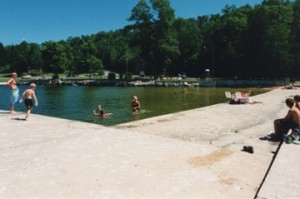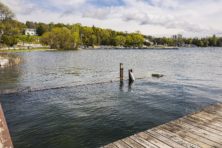Water Level Fixes Possible, But Costly
- Share
- Tweet
- Pin
- Share
Structures could be used to raise water levels in Lake Michigan and Lake Huron as much as 25 cm but at substantial cost and with significant drawbacks, according to a new report from the International Upper Great Lakes Study (IUGLS).
The decline in Lake Michigan water levels in the last decade is plain to see by anyone who takes a drive up the Door County shoreline. Piers that once beckoned kids to jump off them into the waters of Green Bay now look eerily out of place. Dredging is a rite of spring. Beaches are as likely to be grassy as they are sandy.
Many who live on and enjoy the peninsula shoreline want their old images back, but engineering those visions of the past will be costly, according to a joint commission of U.S. and Canadian scientists.
IUGLS board members will be at Third Avenue Playhouse July 18 for a public meeting to discuss the report and gather citizen input. It will be the first of 12 public meetings held throughout the Great Lakes Basin.
The report is part of Phase 2 of the IUGLS. Phase 1 of the study, completed in 2010, determined that climate change was responsible for most of the decline in water levels in Lakes Michigan and Huron since 1962.
After that study was released, citizens urged the study board to investigate engineering options for raising water levels in Lake Michigan and Lake Huron.
The study said submerged concrete sills and an inflatable flap gate could be used in the St. Clair River, where pre-1963 dredging caused a 21-inch drop in the water levels of Lake Michigan and Lake Huron. These would act as speed bumps at the bottom of the river, restricting water flow through the St. Clair.
Those structures could raise water levels up to 25 cm, but they won’t come cheap. The study estimates the cost of those measures would be a minimum of $205 million and could be far greater. The structures could also take decades to construct due to the need for governmental approvals, environmental assessments, engineering and design.

Dave Rack (left) and Chris Miller (right) build a bon fire for Fyr Bal Festival in 2004 where water once covered sand.
The study board also investigated the feasibility of inflatable rubber weirs but found that those have only been tested in small water systems. Another option, in-stream turbines, is only in the exploratory stages.
While engineering efforts could bring water levels up, the study found that it would likely result in a loss in hydropower generation. It would also cause damage to shorelines if water levels were raised more than 25 cm, as well as causing harm to Lake Sturgeon spawning and habitat for endangered species.
“Everything has its trade-offs,” said John Nevin, the IUGLS public information officer.
The complete 187-page report and a slideshow presentation of the report are available at http://www.iugls.org. The final Phase 2 report is scheduled to be submitted to the International Joint Commission, the joint U.S. and Canadian body that oversees the management of joint boundary waters, in March of 2012.


